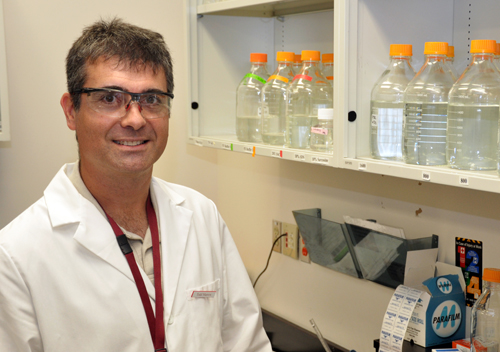
The next time you find a mouse in your food, send the specimen to U of G’s Agriculture and Food Laboratory (AFL). They’ll analyze it to determine how the mouse died – and how it got there. Did it fall in during the food production process, or was it planted?
“We can do an autopsy on the mouse,” says Todd Marrow, B.Sc. ’91, lab manager of diagnostics and business development. “Was the head actually bitten off, or did someone use a knife?”
Finding foreign objects, such as glass, metal and plastic in food is not unusual, he adds. Discovering mice, human hair, fingernails — or worse, fingers – is more unlikely. But when it happens, the lab often receives samples for analysis.
“Here at the Agriculture and Food Laboratory, we’re testing for many different food safety concerns,” says Marrow. Determining the cause of a food-borne illness, for example, involves a combination of scientific analysis and detective work to identify “the usual suspects,” which include Salmonella, Campylobacter, E. coli and Listeria.
The lab also offers a test for Staphylococcus aureus enterotoxin, which was blamed for sickening more than 200 people who consumed cronut burgers at Toronto’s Canadian National Exhibition in August. “This lab is one of very few labs that offer this test,” says Marrow. “A lot of private labs end up sending that test work to us.”
The maple bacon jam used as a condiment on the burger was found to contain the enterotoxin, which causes illness within two to four hours of ingestion. “It’s a concern that shouldn’t be overlooked since it’s quite a rapid-acting food toxin,” says Marrow, adding that the Guelph lab can provide same-day results.
Some bacteria in food can cause symptoms such as nausea, vomiting and diarrhea within a few days. But the enterotoxin from Staphylococcus aureus works within a few hours. “Enterotoxin is derived from bacterial production, but it’s not the bacteria itself,” he explains. Since the enterotoxin works so quickly, the source is usually the last food a person ate before becoming sick.
Bacterial contamination of food often results from improper handling, storage or cooking. Although cooking meat thoroughly often kills any bacteria, it can’t remove the enterotoxin. “A lot of training needs to happen,” he says, especially among short-term food vendors.
Most of the AFL’s clients are food processors and government agencies. Some processors send food samples to the lab before the food appears on store shelves; others send samples only when a problem arises. Major outbreaks are typically managed by Ontario Public Health (OPH) and the Public Health Agency of Canada (PHAC) in their own labs. AFL might receive samples from the Ontario Ministry of Agriculture and Food or referral samples from PHAC or OPH.
The lab has worked on many high-profile food recalls, says Marrow, and its 120 staff go into overdrive during major outbreaks of food-borne illness. The Canadian Food Inspection Agency is responsible for implementing food recalls and relies on a network of labs across the country to conduct testing.
The lab also maintains a library of Listeria monocytogenes, a type of bacteria found in meat produced by Maple Leaf Foods that caused 22 deaths and led to a recall in 2008. When Listeria is suspected in a sample, the lab compares it to more than 2,000 strains in its library to determine whether it has been involved in any food contamination cases.
The lab also specializes in identifying Campylobacter, which Marrow says many labs struggle with because “it’s a tougher organism to isolate, and we’ve got a strong technical background here for that. People will bring their samples here because they know that if that organism is in there, we will find it.”
Identifying bacterial pathogens often involves a DNA test that looks at multiple sections of the DNA strand. “It’s fairly quick and very conclusive,” he says. Other techniques include bacterial cultures. The type of technique used by the lab is often determined by the client or by government regulations, how quickly the results are needed and which test is most cost-effective.
As food contamination grabs more headlines, is it becoming more prevalent? Not necessarily, says Marrow. “I think we’re probably getting better at finding these things.”